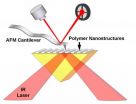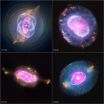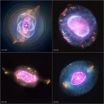(Press-News.org) HOUSTON – (Oct. 10, 2012) – Rice University researchers are doping graphene with light in a way that could lead to the more efficient design and manufacture of electronics, as well as novel security and cryptography devices.
Manufacturers chemically dope silicon to adjust its semiconducting properties. But the breakthrough reported in the American Chemical Society journal ACS Nano details a novel concept: plasmon-induced doping of graphene, the ultrastrong, highly conductive, single-atom-thick form of carbon.
That could facilitate the instant creation of circuitry – optically induced electronics – on graphene patterned with plasmonic antennas that can manipulate light and inject electrons into the material to affect its conductivity.
The research incorporates both theoretical and experimental work to show the potential for making simple, graphene-based diodes and transistors on demand. The work was done by Rice scientists Naomi Halas, Stanley C. Moore Professor in Electrical and Computer Engineering, a professor of biomedical engineering, chemistry, physics and astronomy and director of the Laboratory for Nanophotonics; and Peter Nordlander, professor of physics and astronomy and of electrical and computer engineering; physicist Frank Koppens of the Institute of Photonic Sciences in Barcelona, Spain; lead author Zheyu Fang, a postdoctoral researcher at Rice; and their colleagues.
"One of the major justifications for graphene research has always been about the electronics," Nordlander said. "People who know silicon understand that electronics are only possible because it can be p- and n-doped (positive and negative), and we're learning how this can be done on graphene.
"The doping of graphene is a key parameter in the development of graphene electronics," he said. "You can't buy graphene-based electronic devices now, but there's no question that manufacturers are putting a lot of effort into it because of its potential high speed."
Researchers have investigated many strategies for doping graphene, including attaching organic or metallic molecules to its hexagonal lattice. Making it selectively – and reversibly – amenable to doping would be like having a graphene blackboard upon which circuitry can be written and erased at will, depending on the colors, angles or polarization of the light hitting it.
The ability to attach plasmonic nanoantennas to graphene affords just such a possibility. Halas and Nordlander have considerable expertise in the manipulation of the quasiparticles known as plasmons, which can be prompted to oscillate on the surface of a metal. In earlier work, they succeeded in depositing plasmonic nanoparticles that act as photodetectors on graphene.
These metal particles don't so much reflect light as redirect its energy; the plasmons that flow in waves across the surface when excited emit light or can create "hot electrons" at particular, controllable wavelengths. Adjacent plasmonic particles can interact with each other in ways that are also tunable.
That effect can easily be seen in graphs of the material's Fano resonance, where the plasmonic antennas called nonamers, each a little more than 300 nanometers across, clearly scatter light from a laser source except at the specific wavelength to which the antennas are tuned. For the Rice experiment, those nonamers – eight nanoscale gold discs arrayed around one larger disc – were deposited onto a sheet of graphene through electron-beam lithography. The nonamers were tuned to scatter light between 500 and 1,250 nanometers, but with destructive interference at about 825 nanometers.
At the point of destructive interference, most of the incident light energy is converted into hot electrons that transfer directly to the graphene sheet and change portions of the sheet from a conductor to an n-doped semiconductor.
Arrays of antennas can be affected in various ways and allow phantom circuits to materialize under the influence of light. "Quantum dot and plasmonic nanoparticle antennas can be tuned to respond to pretty much any color in the visible spectrum," Nordlander said. "We can even tune them to different polarization states, or the shape of a wavefront.
"That's the magic of plasmonics," he said. "We can tune the plasmon resonance any way we want. In this case, we decided to do it at 825 nanometers because that is in the middle of the spectral range of our available light sources. We wanted to know that we could send light at different colors and see no effect, and at that particular color see a big effect."
Nordlander said he foresees a day when, instead of using a key, people might wave a flashlight in a particular pattern to open a door by inducing the circuitry of a lock on demand. "Opening a lock becomes a direct event because we are sending the right lights toward the substrate and creating the integrated circuits. It will only answer to my call," he said.
INFORMATION:
Rice co-authors of the paper are graduate students Yumin Wang and Andrea Schlather, research scientist Zheng Liu, and Pulickel Ajayan, the Benjamin M. and Mary Greenwood Anderson Professor in Mechanical Engineering and Materials Science and of chemistry.
The research was supported by the Robert A. Welch Foundation, the Office of Naval Research, the Department of Defense National Security Science and Engineering Faculty Fellows program and Fundacio Cellex Barcelona.
This news release can be found online at news.rice.edu.
Read the abstract at http://pubs.acs.org/doi/abs/10.1021/nn304028b
Follow Rice News and Media Relations via Twitter @RiceUNews
Related Materials:
Laboratory for Nanophotonics: http://lanp.rice.edu/
Images for download:
http://news.rice.edu/wp-content/uploads/2012/10/GRAPHENE-1-WEB.jpg
Nanoscale plasmonic antennas called nonamers placed on graphene have the potential to create electronic circuits by hitting them with light at particular frequencies, according to researchers at Rice University. The positively and negatively doped graphene can be prompted to form phantom circuits on demand. (Rice University)
http://news.rice.edu/wp-content/uploads/2012/10/Nonamers.jpg
Nonamers in the drawings at top and in the photos at bottom are arrays of nine gold nanoparticles deposited on graphene and tuned to particular frequencies of light. When illuminated, the plasmonic particles pump electrons into the graphene, according to researchers at Rice University who say the technology may lead to the creation of on-demand circuitry for electronic devices. (Rice University)
Located on a 300-acre forested campus in Houston, Rice University is consistently ranked among the nation's top 20 universities by U.S. News & World Report. Rice has highly respected schools of Architecture, Business, Continuing Studies, Engineering, Humanities, Music, Natural Sciences and Social Sciences and is home to the Baker Institute for Public Policy. With 3,708 undergraduates and 2,374 graduate students, Rice's undergraduate student-to-faculty ratio is 6-to-1. Its residential college system builds close-knit communities and lifelong friendships, just one reason why Rice has been ranked No. 1 for best quality of life multiple times by the Princeton Review and No. 4 for "best value" among private universities by Kiplinger's Personal Finance. To read "What they're saying about Rice," go to www.rice.edu/nationalmedia/Rice.pdf.
If you do not wish to receive news releases from Rice University, reply to this email and write "unsubscribe" in the subject line. Office of News and Media Relations – MS 300, Rice University, 6100 Main St., Houston, TX 77005
David Ruth
713-348-6327
david@rice.edu
Mike Williams
713-348-6728
mikewilliams@rice.edu
Light might prompt graphene devices on demand
Rice University researchers find plasmonics show promise for optically induced electronics
2012-10-11
ELSE PRESS RELEASES FROM THIS DATE:
Fly like an eagle: New launch and recovery system takes UAV into the future
2012-10-11
A shipboard-capable system designed to support both the launch and recovery of the Scan Eagle unmanned aerial vehicle (UAV) successfully completed final demonstration flight testing Sept. 27 at a testing range in eastern Oregon.
Sponsored by the Office of Naval Research (ONR), the Compact Launch and Recovery System (CLRE) will provide a small-scale solution for the unmanned surveillance craft's operations.
"This system's shipboard capability is unique," said John Kinzer, who manages ONR's Air Vehicle Technology Program. "It's more compact than other systems, so you ...
Improving nanometer-scale manufacturing with infrared spectroscopy
2012-10-11
One of the key achievements of the nanotechnology era is the development of manufacturing technologies that can fabricate nanostructures formed from multiple materials. Such nanometer-scale integration of composite materials has enabled innovations in electronic devices, solar cells, and medical diagnostics.
While there have been significant breakthroughs in nano-manufacturing, there has been much less progress on measurement technologies that can provide information about nanostructures made from multiple integrated materials. Researchers at the University of Illinois ...
The good, the bad, and the guilty: Anticipating feelings of guilt predicts ethical behavior
2012-10-11
From politics to finance, government to education, ethics-related scandals seem to crop up with considerable regularity. As whistleblowers and investigative journalists bring these scandals to light, one can't help but wonder: Are there specific character traits that predispose people to unethical behavior?
Converging evidence suggests that the answer could be guilt proneness.
In a new article in Current Directions in Psychological Science, a journal of the Association for Psychological Science, researchers Taya Cohen and Nazli Turan of Carnegie Mellon University and ...
A planetary nebula gallery
2012-10-11
This gallery shows four planetary nebulas from the first systematic survey of such objects in the solar neighborhood made with NASA's Chandra X-ray Observatory. The planetary nebulas shown here are NGC 6543, also known as the Cat's Eye, NGC 7662, NGC 7009 and NGC 6826. In each case, X-ray emission from Chandra is colored purple and optical emission from the Hubble Space Telescope is colored red, green and blue.
In the first part of this survey, published in a new paper, twenty one planetary nebulas within about 5000 light years of the Earth have been observed. The paper ...
Grape consumption associated with healthier dietary patterns
2012-10-11
Sacramento, CA (October 9, 2012) – In a new observational study presented today at the Academy of Nutrition and Dietetics Food and Nutrition Conference and Exposition (FNCE) in Philadelphia, PA, researchers looked at the association of grape consumption, in the non-alcoholic forms most commonly consumed – fresh grapes, raisins and 100% grape juice – with the diet quality of a recent, nationally representative sample of U.S. children and adults. Their findings suggest that, among adults and children, consumption of grapes and grape products is associated with healthier dietary ...
Analysis finds likely voters rank health care second most important issue in presidential choice
2012-10-11
Boston, MA – A new analysis of 37 national opinion polls conducted by 17 survey organizations finds that health care is the second most important issue for likely voters in deciding their 2012 presidential vote. This is the highest that health care has been ranked as a presidential election issue since 1992. When likely voters were asked to choose from a list of issues, similar to the approach used in election-day exit polls, one in five (20%) named "health care and Medicare" as the most important issue in their 2012 voting choice, far behind "the economy and jobs" (cited ...
Cold cases heat up through Lawrence Livermore approach to identifying remains
2012-10-11
LIVERMORE, Calif. -- In an effort to identify the thousands of John/Jane Doe cold cases in the United States, a Lawrence Livermore National Laboratory researcher and a team of international collaborators have found a multidisciplinary approach to identifying the remains of missing persons.
Using "bomb pulse" radiocarbon analysis developed at Lawrence Livermore, combined with recently developed anthropological analysis and forensic DNA techniques, the researchers were able to identify the remains of a missing child 41 years after the discovery of the body.
In 1968, ...
Sweeping X-ray imaging survey of dying stars is 'uncharted territory'
2012-10-11
The death throes of dying stars are the focus of a sweeping new survey using NASA's Chandra X-ray satellite observatory.
More than two dozen astronomers have aligned their research goals to use Chandra to image a set of dying stars in the neighborhood of the Sun. The resulting X-ray images of these dying stars—called planetary nebulae—are shedding light on the violent "end game" of a Sun-like star's life.
The research team, led by Joel Kastner from Rochester Institute of Technology, won seven days of observing time with Chandra in 2011 to survey and image nearly two ...
Mount Sinai researchers discover gene signature that predicts prostate cancer survival
2012-10-11
Researchers from Mount Sinai School of Medicine have identified a six-gene signature that can be used in a test to predict survival in men with aggressive prostate cancer, according to new research published in the October issue of The Lancet Oncology. This is the first study to demonstrate how prognostic markers may be useful in a clinical setting.
Using blood from 202 men with treatment-resistant prostate cancer, researchers found six genes characteristic of treatment-resistant prostate cancer. Men with the six-gene signature were high-risk, with a survival time of ...
Scientists pinpoint gene variations linked to higher risk of bipolar disorder
2012-10-11
JUPITER, FL, October 10, 2012 – Scientists from the Florida campus of The Scripps Research Institute (TSRI) have identified small variations in a number of genes that are closely linked to an increased risk of bipolar disorder, a mental illness that affects nearly six million Americans, according to the National Institute of Mental Health.
"Using samples from some 3,400 individuals, we identified several new variants in genes closely associated with bipolar disorder," said Scripps Florida Professor Ron Davis, who led the new study, which was published recently by the ...
LAST 30 PRESS RELEASES:
UVA’s Jundong Li wins ICDM’S 2025 Tao Li Award for data mining, machine learning
UVA’s low-power, high-performance computer power player Mircea Stan earns National Academy of Inventors fellowship
Not playing by the rules: USU researcher explores filamentous algae dynamics in rivers
Do our body clocks influence our risk of dementia?
Anthropologists offer new evidence of bipedalism in long-debated fossil discovery
Safer receipt paper from wood
Dosage-sensitive genes suggest no whole-genome duplications in ancestral angiosperm
First ancient human herpesvirus genomes document their deep history with humans
Why Some Bacteria Survive Antibiotics and How to Stop Them - New study reveals that bacteria can survive antibiotic treatment through two fundamentally different “shutdown modes”
UCLA study links scar healing to dangerous placenta condition
CHANGE-seq-BE finds off-target changes in the genome from base editors
The Journal of Nuclear Medicine Ahead-of-Print Tip Sheet: January 2, 2026
Delayed or absent first dose of measles, mumps, and rubella vaccination
Trends in US preterm birth rates by household income and race and ethnicity
Study identifies potential biomarker linked to progression and brain inflammation in multiple sclerosis
Many mothers in Norway do not show up for postnatal check-ups
Researchers want to find out why quick clay is so unstable
Superradiant spins show teamwork at the quantum scale
Cleveland Clinic Research links tumor bacteria to immunotherapy resistance in head and neck cancer
First Editorial of 2026: Resisting AI slop
Joint ground- and space-based observations reveal Saturn-mass rogue planet
Inheritable genetic variant offers protection against blood cancer risk and progression
Pigs settled Pacific islands alongside early human voyagers
A Coral reef’s daily pulse reshapes microbes in surrounding waters
EAST Tokamak experiments exceed plasma density limit, offering new approach to fusion ignition
Groundbreaking discovery reveals Africa’s oldest cremation pyre and complex ritual practices
First breathing ‘lung-on-chip’ developed using genetically identical cells
How people moved pigs across the Pacific
Interaction of climate change and human activity and its impact on plant diversity in Qinghai-Tibet plateau
From addressing uncertainty to national strategy: an interpretation of Professor Lim Siong Guan’s views
[Press-News.org] Light might prompt graphene devices on demandRice University researchers find plasmonics show promise for optically induced electronics




